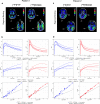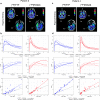Head-to-head comparison of tau positron emission tomography tracers [18F]flortaucipir and [18F]RO948
- PMID: 31612245
- PMCID: PMC6974501
- DOI: 10.1007/s00259-019-04496-0
Head-to-head comparison of tau positron emission tomography tracers [18F]flortaucipir and [18F]RO948
Abstract
Purpose: [18F]flortaucipir binds to paired helical filament tau and accurately identifies tau in Alzheimer's disease (AD). However, "off-target" binding interferes with the quantification of [18F]flortaucipir in several brain regions. Recently, other tau PET tracers have been developed. Here, we compare [18F]flortaucipir with the novel tau tracer [18F]RO948 head-to-head in vivo.
Methods: We included 18 participants with AD, three with amyloid-β-positive amnestic mild cognitive impairment, and four healthy controls. All underwent [18F]flortaucipir (80-100 min) and [18F]RO948 (70-90) PET scans within approximately 1 month. Four study participants underwent 0-100-min dynamic scanning. Standardized uptake value ratios (SUVRs) were created using an inferior cerebellar reference region.
Results: Neocortical tracer retention was highly comparable using both SUVR and distribution volume ratio-1 values obtained from dynamic scans. However, [18F]RO948 retention was significantly higher in the entorhinal cortex and lower in the basal ganglia, thalamus, and choroid plexus compared with [18F]flortaucipir. Increased off-target binding was observed with age for both tracers. Several cases exhibited strong [18F]RO948 retention in the skull/meninges. This extra-cerebral signal, however, did not affect diagnostic accuracy and remained relatively unchanged when re-examining a subsample after 1 year. Kinetic modeling showed an increase in [18F]flortaucipir SUVR over the scanning interval, compared with a plateau for [18F]RO948.
Conclusion: [18F]RO948 and [18F]flortaucipir bound comparably in neocortical regions, but [18F]RO948 showed higher retention in the medial temporal lobe and lower intracerebral "off-target" binding. Time-dependent bias of SUVR estimates may prove less of a factor with [18F]RO948, compared with previous tau ligands.
Keywords: Alzheimer’s disease; Head-to-head; Neurodegeneration; PET; Tau.
Conflict of interest statement
AL, JJ, TO, and OS report no disclosures. RS has served as a (non-paid) consultant for Roche. MS has served on an advisory board for Servier. OH has acquired research support (for the institution) from Roche, GE Healthcare, Biogen, AVID Radiopharmaceuticals, Fujirebio, and Euroimmun. In the past 2 years, he has received consultancy/speaker fees (paid to the institution) from Biogen and Roche.
Figures






References
Publication types
MeSH terms
Substances
LinkOut - more resources
Full Text Sources
Medical

